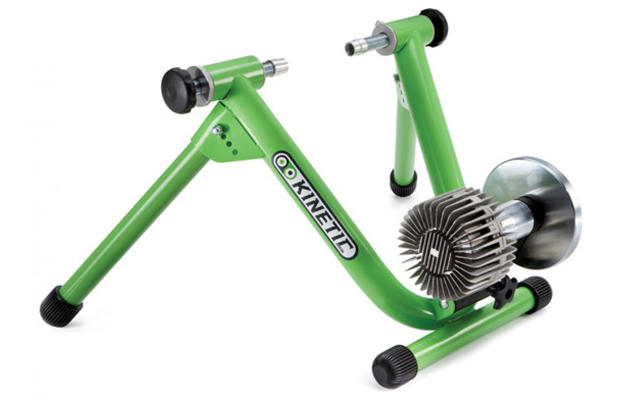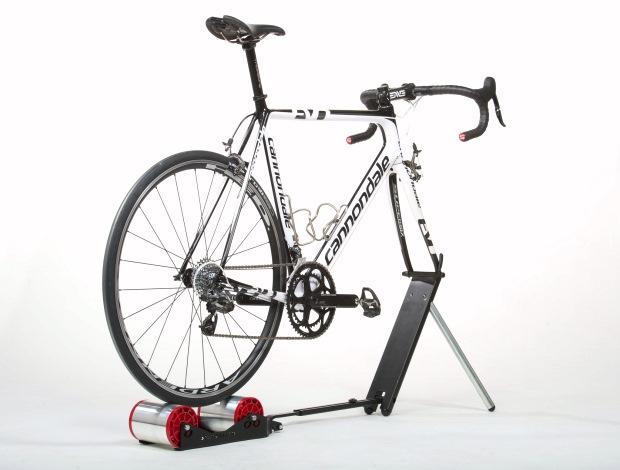Real Men Ride the Rollers
Rollers are cool, like fixies are cool (or were until hipsters swarmed them). In fact rollers and fixed-geared bikes kind of go together. You're more likely to see track riders aboard rollers than any other cohort of cyclist. Riding rollers, like riding fixed-geared bikes, requires skill.
Traditional rollers have three drums, one for the front wheel and two for the rear. You have to steer the bike with a bit of skill or you'll fall off the rollers and off your bike. This style of roller is often a bit less nail biting than it used to be. Rollers are a little wider now and the drums are often concave or they have one of a number of features that guide or tease your bike back toward the center, and solidly on the rear drums.
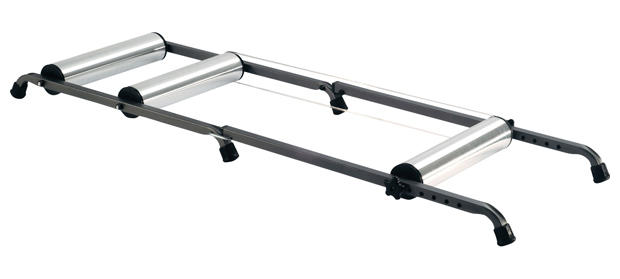
There are two ways to ride the rollers, either "freestyle" and that's just my own word because I can't think of a better one; or with a fork stand. If you use a fork stand you're not in danger of rolling or falling off the rollers, but you're not getting the full roller experience. Personally, were I going to use rollers regularly I would probably build platforms on one or both sides of the rollers, or put my rollers next to the couch, because I'm probably going to fall at some point.
The image below of a set of Kreitler rollers shows a lot of features of rollers. The fork stand, and the front drum, are either/or. If you never intend to ride free on the rollers you can just buy rollers built for a fork stand. But I think that kind of defeats the purpose of rollers.
In the Kreitler Rollers image below you'll see a small belt in the rear that turns a flywheel. One problem with all stationary trainers is the herky-jerky ride quality compared to riding outdoors, especially when coasting. Makers of stationary trainers have all faced this and usually deal with it through the use of a flywheel. Typical mag or fluid trainer flywheels are more in the range of 6 to 7 pounds (Kurt Kinetic sells an aftermarket 12-pound flywheel for its trainers).
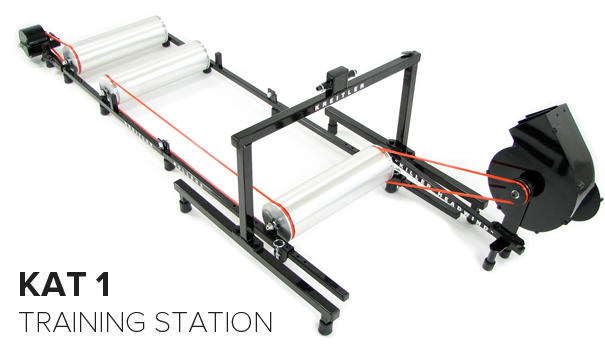
In that Kreitler picture, in front you have the famous Kreitler "resistance" unit, a belt attached to a fan, and it's called the Killer Headwind. This is a double entendre known to bike industry veterans. For years until his death in 2001 you'd find grey-bearded, Kansas-bred Al Kreitler at his Interbike booth wearing his trademark jean overalls with a front pocket. You'd see him selling his Kreitler Rollers with the Killer Headwind and Killer himself – a Yorkshire Terrier who might have weight 5 pounds – rode (ubiquitously) in Al's front overall pocket.
The Killer Headwind was, to my recollection, the first resistance unit in modern rollers – vintage rollers from the first half of the 20th Century sometimes featured very large and heavy drums that acted as both resistance and flywheel (see the image far below). They were hard to spin up, harder to keep going, harder to stop. And higher off the ground. Rollers like that would be inconvenient for most people today.
As regards resistance, the gold standard in rollers is the same progressive and non-linear resistance – increasing at a much greater rate than velocity, like what happens when you ride outdoors – that you find in dumb trainers. Sportcrafters' OverDrive Pro Rollers (below) use its OverDrive Drum to generate, according to the maker: the powerful resistance of a fluid trainer… in a non-linear fashion.
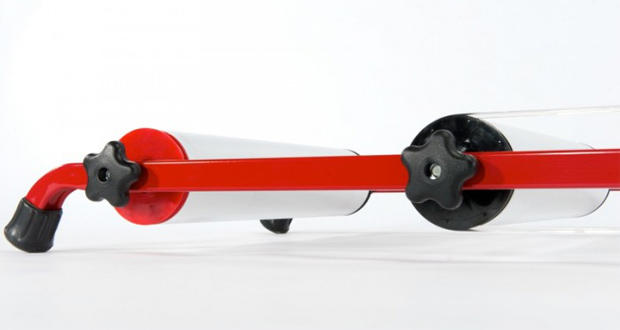
While the resistance unit in the Sportcrafters drum acts like a fluid trainer, the job is accomplished more as it is in mag trainers, with magnets that rely on an eddy current for resistance. The progressive fluid-like resistance is effected using magnets, springs and centrifugal force. It's like what you see in the CycleOps Magneto trainer, but the methods are sufficiently different so that each companies' patents don't overlap.
Sportcrafters, the company – the personnel – is an anomaly. You might think this is vintage technology, with "low tech" rollers outpaced by stationary trainers, an industry still clinging by its fingernails to a sliver of stationary market share. But rollers are, nowadays, quite high-tech, and Sportcrafters' owner, Pete Colan, is himself a triathlete and is attached to South Bend, Indiana-area Spin Zone Cycling which, beside being a Cannondale and Felt dealer, was an early adopter of the GURU fit bike and the F.I.S.T. Bike Fit protocol.
TruTrainer is another roller manufacturer spending a lot of effort trying to solve both the inertial and resistance problems common to all makers of stationary trainers of all sorts. TruTrainer (image below) claims that a rider on its rollers can coast for up to 30 seconds without the drums spinning down to an unrideable speed. That's fantastic. Very roadlike. Really, this is TruTrainer's claim to fame. It is not going to generate the resistance that Sportcrafters or CycleOps trainers will, rather it's got a high speed tubular flywheel inside the rear drum, driven off the middle drum via a belt that turns that flywheel 4 times faster than the drum itself turns.
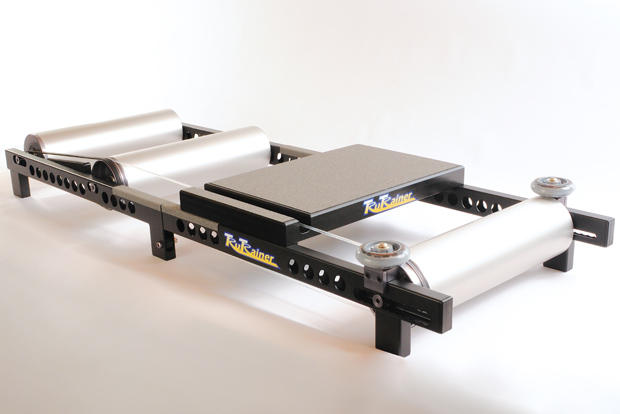
If you're looking for more than resistance in the low-300-watt range, you probably to look at Sportcrafters, CycleOps, Inside Ride, something other than TruTrainer. But if training below 350 watts is enough for you, and you want the ability to coast without crisis, then this is your trainer.
Smart Rollers
TruTrainer is working right now on a smart resistance unit in its middle drum. It's already far along the road to developing its own digitized sensor that transmits roller metrics via either Bluetooth or Ant+ head units. Assuming this resistance unit comes to market, this would make Tru Trainer a "smart" roller. The nice thing about roller manufacturers – all of them – is that the technology almost always exists in the drum. This means backward compatibility and maybe even cross-compatibility between roller makers.
One smart roller currently in existence is from the Italian company Elite. Its rollers have a resistance unit built into the drum, and its highest-end model has 16 resistance levels all controllable through their own handlebar controller. They offer "My Etraining App" which grants the user access to most of the kinds of community and structured training experiences Slowtwitchers want.
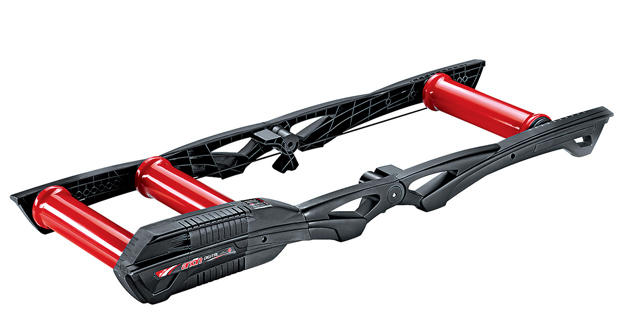
Elite offers a lot of rollers, but here's where it gets a little confusing. It licenses some roller technology from E-Motion (Inside Ride), that allows the rollers to be ridden more easily by those naïve to rollers. But those rollers aren't available in the U.S. Further, the smart roller technology described above isn't, to the best of my knowledge, paired with the easier-to-ride technologies (though all of Elite's drums have a concave lip at the outside that helps keep the wheel from migrating off the roller entirely). Also, Elite has a relationship with Performance Bike, and models sold there are different than those sold at other IBDs.
Elite's rollers (the Arion digital is pictured above) do not pay the same attention to inertial devices that exist in, most notably, Tru Trainer's rollers. You have to decide the features you want. No roller manufacturer has it all.
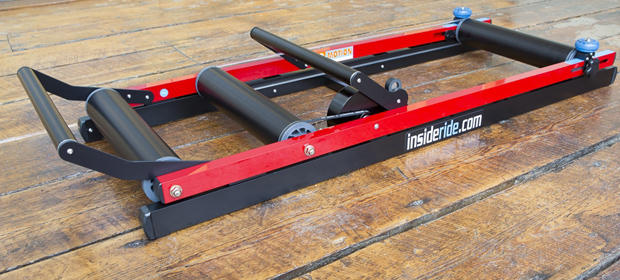
Inside Ride Rollers are the least traditional of all the rollers on the market. They have one overriding technical feature not found on any other rollers except on certain Elite products found outside the U.S.: The rollers sit atop another frame, and these two frames move independent of each other. This allows the rider to vibrate, oscillate, and herky-jerk the way riders do when they ride without that movement translating directly to the drums.
There are other features you'll find in these rollers, such as bumpers that sit just in front of and behind the midpoint of the rear wheel, and a pair of what look like inline skate wheels on either end of the front drum (this is also available, via license, on Tru Trainer's rollers).
Inside Ride is also very close to offering a "smart" roller product. It's got an eddy brake that offers resistance, external to the drums (the eddy brake is built into the drum with TruTrainer and CycleOps rollers). Inside Ride's resistance is controlled wirelessly by its own handlebar-mounted device. It's got a product in beta that allows other devices to talk to the resistance unit. This makes Inside Ride a true smart trainer.
Were I to make a guess, I'd say that Inside Ride is closer to a trainer more triathletes might ride than any other, though I really like the technologies in both TruTrainer and Sportcrafters. I wish I could get TruTrainer's flywheel drum, and Sportcrafters' resistance unit, on an Inside Tri chassis.
There are a couple of fork mounted rollers out there, I think I like them for pre-race warm-up. They're compact, you don't have to mount the bike's rear dropouts into a trainer, it's really the way to go for mobile stationary training or race warm-up or warm-down. I would not use these for my everyday indoor training, because a lot of the value of trainers – specifically the bike handling and road-specificity elements that rollers do better than trainers do – are lost with the fork mount.
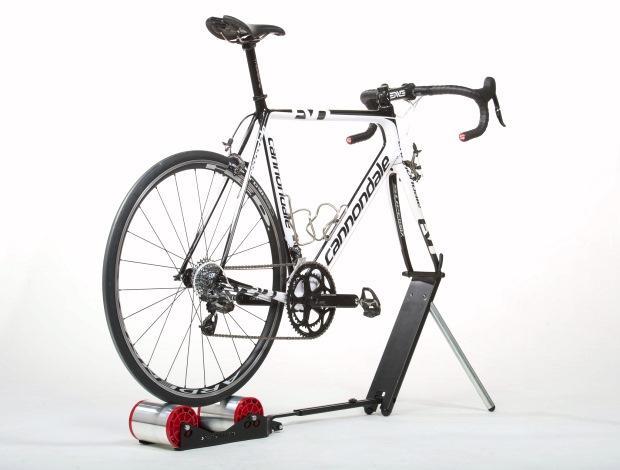
One of these is the pictured Sportcrafter Omni, which we review elsewhere on Slowtwitch. This is the kind of product you're likely to see at bike races and used by pro triathletes at ITU races.
Roller Racing
When I started cycling in the 1970s roller racing was already a thing we did in the Winter. Rollers were pretty basic, very little thought given to flywheels, inertia, resistance. The fellow who could spin the fastest cadence won the race. Here's an image of roller racing from the middle of the last century, look at the size of those drums! There was a platform between them, because the drums were so large the rider couldn't mount and dismount is bike without it.
The typical way to contest a roller race like this was much like a car race around an oval, where you don't start from a standstill, rather there were two hands on a face the size of a large pool clock, each revolution of the clock equally 200 meters, and each rider rode slowly, calibrating the hands so that they were together. Riders started racing "on the top" and finished after, say, 3 revolutions of the clock.
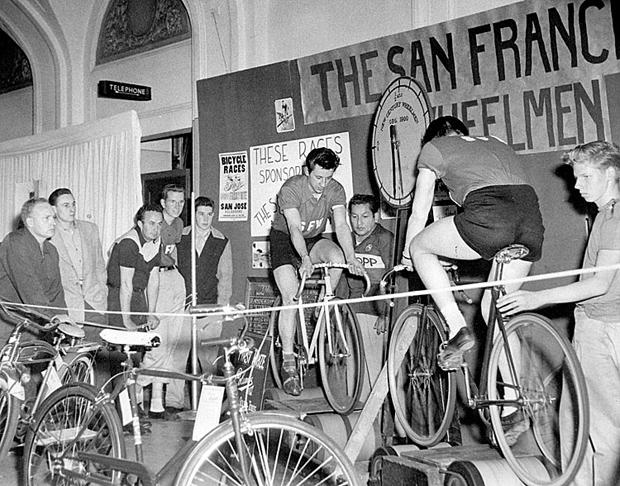
Today roller racing still takes place, mostly among a subculture of enthusiasts. It's bigger in Europe. You can find roller racing taking place in English pubs and I even saw pictures of one that occurred at a wedding. There is one difference: most of the racing taking place these days is with fork-mounted rollers. It's a big ask to expect pub customers to mount a bike and ride standard rollers.
If roller racing rises in popularity I suspect it'll be via some of the smart technologies connecting rollers to the cloud. I can't find any reason why you couldn't race today on trainers in virtual races using Virtual Power, just as you do with dumb trainers.
Price
Basic rollers will cost you about $300, which is pretty close to what you'd pay for a typical dumb trainer. At the very top of this page is an image of CycleOps rollers, and these will work and they are in the $300 range. For the high-$300s you'll get this same CycleOps roller with the non-linear resistance curve just like you'd get in a Sportcrafters OverDrive roller. Either of these rollers that offer this kind of resistance would be a great deal for $400 or less.
Another set of circa-$300 rollers are those made by Cascade, image just below. At this price point ($250 to $350) what you're looking at, and for, are no-frills rollers that fold, have decent sized drums, and have well made drums that are turned true. No, Cascade is not unique, most rollers are foldable.
If you want something else in a roller, you very quickly jump up toward $1000. The TruTrainer rollers are in that price range and it's because their system for maintaining inertia is just expensive to make. The Elite Arion Digital is that company's smart roller and it's going to cost over $800.
Inside Ride is another $900 (or more) roller. Seems a lot, but there's a lot going on in a a set of Inside Ride rollers.
Trainer or Rollers?
What I don't like about trainers is the non-roadlike feel, no attention paid to handling, except for the manhandling of the bike by a combination of me gyrating aboard the bike while the trainer holds it. As noted, riders move their bike a lot during riding and stationary trainers don't allow the bike to move. Rollers offer a very roadlike experience, they don't stress the bike, they don't stress the tire, they allow you and your bike to move naturally. Rollers are also easier to use if your bike is going to be taken on and off the trainer, because you simply place your bike on the rollers and go. No mounting the bike to the rollers.
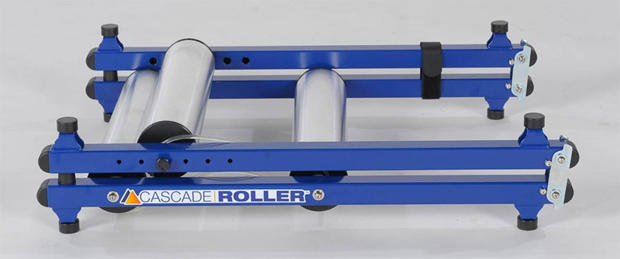
What I don't like about rollers is on a list just as long. Really, if this is what you're using as your go-to stationary trainer, I'd build a kind of roller cave inside your pain cave, with platforms to mount and dismount, and bail out options for that moment when you are going to ride off the roller. The roller will teach you to ride better, but does require you to ride better.
This means no daydreaming while on the roller. And that might be a problem, because you might want to just mindlessly ride. You also can't perform a structured workout on rollers paying 100 percent attention to effort. You have to split your attention between handling and effort.
I, personally, would not spend any meaningful time aboard rollers without a significant inertial solution. That means either TruTrainer, or Kreitler or Inside Ride with their outboard, belt-driven flywheels, or I'd need to try Sportcrafters' or CycleOps' resistance-unit rollers to see if the spin-down was too quick or whether it's okay. (I don't know, I haven't tried them.)
We're taking a poll of you all right now and it's early, but, it seems as if about 7 percent of you all are roller enthusiasts. The rest of you are trainer enthusiasts. About a third of you have zero interest in even trying rollers. About about a quarter of you are intrigued.
If you have a few more minutes to spend, here is one, then another, Youtube video of somebody trying out rollers for the first time. In both these cases they are Inside Ride rollers. You'll see links to others' first experiences on rollers. Pretty funny. Here's a fellow that shared a video of him on his Inside Ride rollers 2 months after first getting them, after 20 or so rides. After a little bit of shakiness mounting up, he proceeds to demonstrate both riding out of the saddle and riding no hands.
Can rollers be ridden while on the aero bars? Slowtwitch Reader Forum members report that they do so. Probably most easily on Inside Ride rollers.
Unfortunately, as opposed to the old days when I came up cycling, rollers are no longer ubiquitous at local bike shops. You kind of have to take a leap of faith if you want to invest in rollers, especially the higher-end models. Real men take the plunge.


